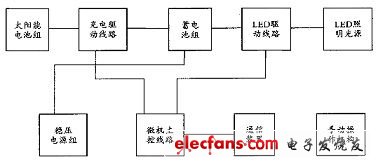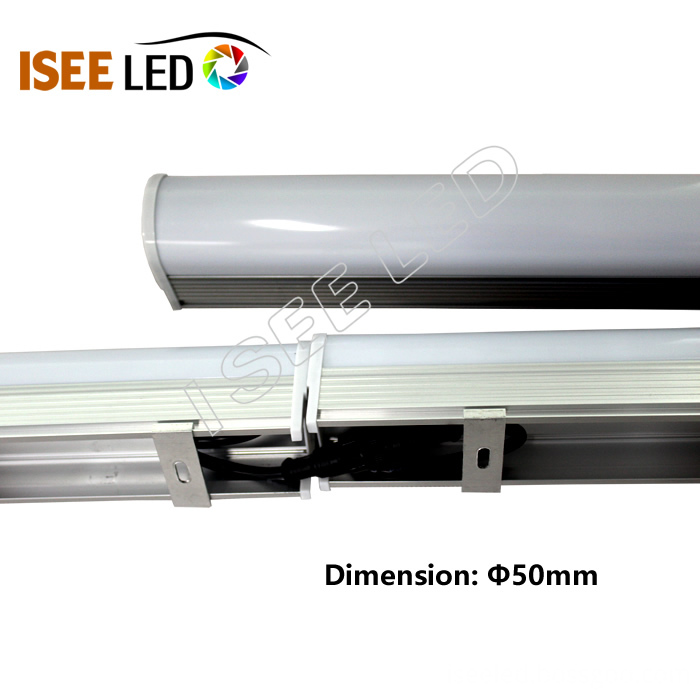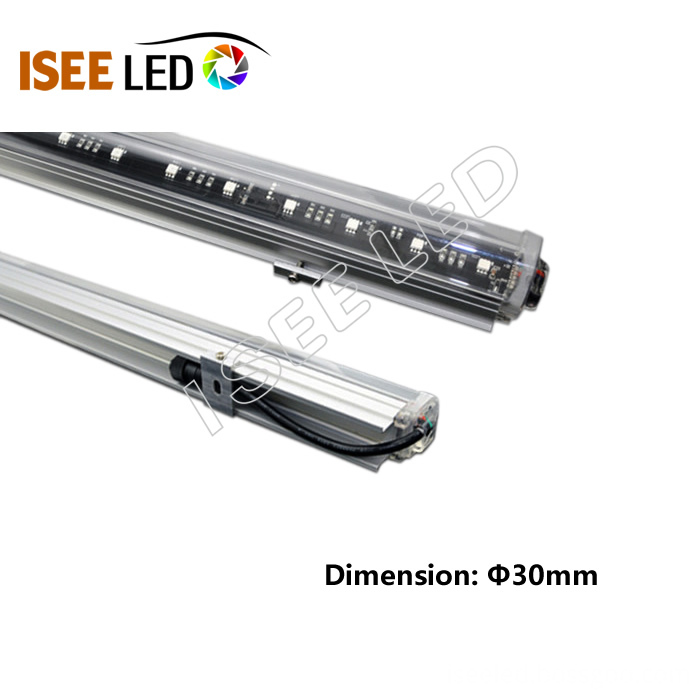0 Preface With the increasing energy of global energy, solar photovoltaic lighting has developed rapidly. In the development of solar lighting systems, people constantly analyze the control modes commonly used in lighting systems, design various practical working modes, and the light source technology is constantly being updated. The charging mode of the battery is also constantly researching. In the exploration, the effective utilization rate is getting higher and higher. In the development and coordination of various components of solar energy, solar lighting systems are constantly evolving. 1 Principle and composition of solar lamps The solar luminaire system is a DC-type independent photovoltaic system. Solar modules convert solar energy into electrical energy, which is controlled and protected by a controller that converts electrical energy into chemical energy that is stored in the battery. When electricity is used, the battery converts chemical energy into electrical energy for use by a DC load, or inverters for AC power for AC loads. This device stops working only when there is no light for a long time and the power in the battery is used up. The solar street light consists of the following components: solar panels, solar controllers, battery packs, light sources, light poles and lamp housings, and some have inverters. 1) Solar panels Solar panels are the core of solar streetlights and the most valuable part of solar streetlights. Its role is to convert the radiant energy of the sun into electrical energy, or send it to the battery for storage. Solar cells are mainly made of single crystal silicon and polycrystalline silicon. The photoelectric conversion efficiency of single crystal silicon is 13% to 15%, and the polycrystalline silicon is 11% to 13%. The latest technology also includes photovoltaic thin film batteries. 2) Solar controller The most important part of the solar luminaire system is the controller, whose performance directly affects the life of the system, especially the battery life. The controller uses the industrial grade MCU as the main controller to control the opening and closing of the MOSFET device by measuring the ambient temperature, controlling the voltage and current parameters of the battery and the solar cell module, and achieving various control and protection functions. 3) Battery Since the input energy of the solar photovoltaic system is extremely unstable, it is generally necessary to configure the battery system to work. Generally, there are lead-acid batteries, Ni-Cd batteries, and Ni-H batteries. The choice of battery capacity generally follows the following principles: First, the energy of the daytime solar cell module is stored as much as possible while meeting the nighttime illumination, and at the same time, it is also necessary to store the electric energy required for the nighttime illumination of the continuous rainy day. If the battery capacity is too small, it can not meet the needs of night lighting. The capacity is too large. On the one hand, the battery is always in a deficient state, which affects the battery life and causes waste. The battery should match the solar battery and the electrical load (street light). A simple way to determine the relationship between them. The solar cell power must be more than 4 times higher than the load power for the system to work properly. The voltage of the solar cell should exceed 20% to 30% of the operating voltage of the battery to ensure normal negative charge to the battery. The battery capacity must be more than 6 times higher than the daily load of the load. 4) Light source What kind of light source is used for solar street lamps is an important indicator for whether solar lamps can be used normally. Generally, solar lamps use low-voltage energy-saving lamps, low-pressure sodium lamps, electrodeless lamps, and LED light sources. LED light source has a long life, up to 1000000 hours, low working voltage, no inverter, high light efficiency, domestic 50lm/W, imported 80lm/W. As technology advances, the performance of LEDs will increase further. 5) The height of the pole and the lamppost of the lamp housing shall be determined according to the width of the road, the spacing of the lamps, and the illumination standard of the road. According to the collection of many foreign solar light materials, most of the light-emitting equipments are designed to save energy. The appearance of the lamps is not high, so it is relatively practical. 2 Solar street lighting control system 1) System structure The solar street light computer monitoring system consists of microcomputer main control circuit, solar panel, battery charge and discharge device, battery pack, LED light source drive and LED light. The system composition is shown in Figure 1: Figure 1 Solar street light microcomputer monitoring system structure 2) Function control (1) Basic requirements for solar street light controllers Solar street lights are made up of multiple LED lights in series. The street lighting system not only consumes a lot of electric energy, but also requires huge daily maintenance costs, which brings the dual pressure of power supply and financial expenditure to the city. Developing a "on-demand lighting" power supply strategy can alleviate this contradiction. Through programming, it can realize flexible and flexible control of street lamps distributed in the bustling sections of the city. It can realize switching control by PWM mode in any time period to achieve the purpose of saving electricity and setting off the city lighting atmosphere. The basic requirements for control are as follows: 1 control the brightness of the first half of the night and the second half of the night, the control ratio depends on the situation; 2 turn on the single side street light strategy, that is, the battery is only used for one street light, the other street light is off; 3 half night light strategy, that is, the middle of the night Turn on the light, turn off the light in the middle of the night, the battery is only used for the first half of the night. Solar street lights are controlled by the intensity of natural light to control the lighting fixtures. The optimal design of these solar-controlled solar lighting systems is the prerequisite for long-term reliable operation of the system. System capacity can be optimized based on local geographic location, weather conditions and load conditions. However, due to seasonal factors, the solar radiation in winter is less than that in summer. The solar array generates less electricity in winter than in summer, but the amount of electricity needed to be illuminated in winter is more than that in summer, which makes the lighting system's power generation and power consumption contrast. Balance monthly power generation surplus and power consumption loss. In order to improve the utilization rate of lighting system power generation and overcome the shortcomings caused by system power shortage, in the development of solar energy lighting system, people constantly analyze the common control modes of lighting system and design various practical working modes. The light source technology is also constantly being updated. The charging mode of the battery is also increasingly utilized in the continuous research and exploration. Therefore, in the development and coordination of various components of solar energy, the solar lighting system is constantly improving. . According to the characteristics of the solar street lamp system, the street lamp operation must take into account the influence of the remaining capacity of the battery. When the street light is normally turned on, the current battery capacity is obtained according to the battery residual capacity detection method. After the inquiry, the power supply time to be maintained by the battery is obtained, and the current battery power is used on average, and the street light illumination mode is flexibly controlled according to the battery power that can be used that night. Reasonable use of the battery's existing power. (2) Battery charge and discharge control function Battery charge and discharge control is an important function of the whole system, which affects the operating efficiency of the entire solar street light system and also prevents overcharging and overdischarging of the battery pack. Overcharging or overdischarging of batteries has a serious impact on their performance and lifetime. The charge and discharge control function can be divided into switch control (including single and multi-switch control) type and pulse width modulation (PWM) control (including maximum power tracking control) according to the control mode. The system adopts a pulse width modulation controller method and uses a MOS transistor as a switching device. When the daytime is sunny, according to the remaining capacity of the battery, select the corresponding duty cycle mode to charge the battery, and strive to charge efficiently; at night, adjust the duty cycle to adjust the LED light according to the remaining capacity of the battery and the future weather conditions. Brightness to ensure a balanced and rational use of the battery. In addition, the system also has a protection function for overcharging the battery, that is, when the charging voltage is higher than the protection voltage (15V), the charging voltage of the battery is automatically lowered; after that, when the voltage drops to the maintenance voltage (13.2V), the battery enters the floating state. When it is lower than 13.2V, the float is turned off and enters the equalization state. When the battery voltage is lower than the protection voltage (11V), the controller automatically turns off the load switch to protect the battery from damage. Charging by PWM can not only maximize the efficiency of the solar panel, but also improve the charging efficiency of the system. This design has corresponding protection measures for reverse connection, overcharge and over discharge of the battery. (3) Solar street light operation mode control function High-brightness and high-current LED lamps have been widely used because of the same brightness, which is about 90% less than incandescent lamps. Nowadays, there is a tendency to gradually replace conventional lamps. The solar street light is made up of a plurality of LED lights connected in series, and the brightness is adjustable by PWM mode, that is, the current flowing through the LED is changed through the EN end, thereby adjusting the brightness of the LED lamp, and the current intensity can be from several milliamperes to 1 amp, and finally the LED lamp is finally made. Achieve the desired brightness. The PWM signal can be generated by the microcontroller or by other pulse signals. The PWM signal can change the current through the LED lamp from 0 to the rated current to change the LED lamp from dark to normal brightness. The smaller the PWM duty cycle (higher time), the higher the brightness. Using PWM to control the brightness of the LED is very convenient and flexible. It is the most commonly used dimming method. The frequency of PWM can range from tens of Hz to several thousand Hz. PWM dimming is achieved by controlling the MOSFET transistors. Since the voltage used in the street lamp unit of the system is generated by several batteries in series, when selecting a MOSFET transistor, first consider the withstand voltage of the MOSFET. The system requires that the withstand voltage of the MOSFET be higher than 40V. Secondly, according to the driving LED lamp current The size of the MOSFET's IDS is the maximum current. In the case of DC power supply, the first consideration is the IDS maximum current value and RDS value. Under normal circumstances, the maximum current of the IDS of the MOSFET should be more than 5 times that of the LED lamp. In addition, the internal resistance of the MOSFET should be small. The larger the LED drive current, the smaller the RDS should be. The smaller the RDS, the more the conversion efficiency. high. Urban solar street lights are public facilities closely related to people's lives. To a certain extent, they reflect the degree of prosperity and development of the city. In the past, the renewal of street lamps has been limited to the lighting part. With the development of urban and electronic technology, the urban street lamp system has undergone the development process of manual control, automatic timing/photoelectric control, and computer program control. The use of computers to realize the automatic control of urban solar street lighting systems has good economic and social benefits for improving the modern management level of the city and saving manpower and material resources. By effectively adjusting the light switch time, the work quality and work efficiency of the street lamp system can be greatly improved, and the urban lighting system can be improved by providing comprehensive solutions and powerful technical support for the operation, maintenance and expansion of the urban lighting system. Management level. (1) Microcomputer main control line. The microcomputer main control circuit is the control core of the whole system, which controls the normal operation of the entire solar street lamp system. The microcomputer main control circuit has a measurement function. By detecting and judging the parameters of the solar panel voltage and the battery voltage, the corresponding lines are controlled to be turned on or off to realize various control and protection functions. (2) Charging drive line The charging drive circuit consists of a MOSFET drive module and a MOSFET. The MOSFET driver module uses high-speed optocoupler isolation, emitter output, short-circuit protection and fast shutdown. The selected MOSFET is an isolated and energy-saving single-chip switching power supply IC. The full voltage input range of driving LED is 150~200V, and the output current is 8~9A. Wide input voltage range, good voltage regulation and load regulation, strong anti-interference ability and low power consumption. The system completes the charging of the solar battery pack to the battery through the charging drive line, and the corresponding protection measures are also provided in the circuit. (3) LED drive circuit It is composed of IGBT drive module and MOSFET to realize the adjustment of the brightness of the street lamp and the switch of the street lamp. (4) Solar battery pack The solar cell consists of solar cells (operating voltage of about 0.5V, operating current of about 20-25mA/cm2, area of ​​10cm & TImes; 10cm) connected in series and in parallel, and a standard component consists of 36 monomers. A solar cell module can generate approximately 17V of voltage to become a battery pack with a rated voltage of 12V. When an application system requires higher voltage and current components, multiple components can be assembled into a solar cell array to achieve the required voltage and current. (5) Battery pack Since the energy obtained from the photovoltaic array does not always match the demand of the electronic load, the battery can still operate the load when the photovoltaic array itself cannot provide sufficient power. If the electronic load needs to work at night or on a cloudy or cloudy day, energy storage is required. The storage energy of the battery is designed to meet the average daily electronic load demand during autonomous operation. In general, you should be able to reserve 5 to 7 days of nighttime lighting power. In an independent photovoltaic system, the electrical energy generated by the photovoltaic array is not always used while the electrical energy is being generated, so a battery is required in most independent photovoltaic systems. (6) Communication device It consists of a wireless data transmission module. The wireless data transmission module supports GPRS, with RS-232 interface, communication distance up to 100 meters, strong anti-interference, free from broadcast TV, mobile communication interference, and realize communication between adjacent street lamp terminals.
DMX LED Tube Light 6060 is DMX RGB tube light, width is 60mm and height is also 60mm. The led tube is rgb color dmx lighting, can be used as Xtube, mediatube, outdoor tube for creative lighting solutions, such as make a 3D cube. led tube color have rgb color tube, rgbw color tube. Regarding how to program led light, because the light is dmx programming, so ISEELED dmx Led Controller or Artnet Controller are suggested. ISEELED DMX512 Led Linear Tube compete with eurolite led tube, osram led tube, Philips led tube, american dj led tube. The pixel tube have 1led 1pixel, 2led 1pixel, 3led 1pixel, 6led 1pixel. Address setting have two type, one is auto address, another is manual address. That's to say we have led tube auto and led tube manual. Auto LED Linear Tube , you don't need assign dmx address, it's convenience for event show and led light rental. Manual led linear tube, you need assign dmx address by Address Writer before light up, for DJ club, architecture light, it's ok.
Photo show of Dmx Led Tube :
Dmx Led Tube Light,Dmx Led Tube,Dmx Led Lights,Led Dmx Lights Shenzhen Iseeled Technology Co., Ltd. , https://www.iseeledlight.com

